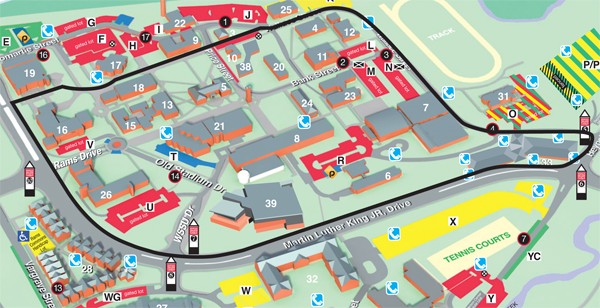Wellness Trail
Health and Wellness is a goal we all share and the WSSU Wellness Trail is a great way for students, faculty and staff to get out and exercise while on campus. Take a break from your day and walk the one mile loop with your roommates, classmates or colleagues. With moderately steep grades in some parts, the loop will get your blood pumping and your heart rate up! Elevation changes over the trail by approximately 120 feet with the lowest elevation being 764 feet and the highest at about 884 feet.

Walking is one of the simplest and least expensive ways to increase one's physical activity level and improve one's overall health. It is a weight-bearing exercise that helps maintain bone density and is easy on joints. Walking at a brisk pace is considered moderate-intensity physical activity, and doing this most days of the week for 30 minutes or more enables you to meet the criteria for physical activity for health benefits recommended by ACSM and the American Heart Association.

How long will it take you to walk the Wellness Trail? How many calories will you burn completing the loop? The information below will help you determine how fast you are moving and how many calories you are burning. For example, if it takes you 12 minutes to walk one mile, your speed is 5 miles per hour. One's speed and a few other variables influence the volume of oxygen one consumes - or VO2. How much oxygen one consumes relates to the calories one burns and this depends on bodyweight, so we have added calculations for people of differing weights.
People in these weight ranges will burn between 90 and 240 calories by walking one mile. A 12 oz can of soda has about 140 calories, so a 70 kg (154 lb) person needs to walk one mile to walk off that soda.
| Time (min:sec) | 50 kg (110 lb) | 60 kg (132 lb) | 70 kg (154 lb) | 80 kg (176 lb) | 90 kg (198 lb) | 100 kg (220 lb) | 110 kg (242 lb) | Approx. Steps |
|---|---|---|---|---|---|---|---|---|
| 30 | 103 | 123 | 144 | 164 | 185 | 205 | 226 | 2000-2500 |
| 24 | 97 | 117 | 136 | 156 | 175 | 195 | 214 | 2000-2500 |
| 20 | 94 | 113 | 131 | 150 | 169 | 188 | 207 | 2000-2500 |
| 17 | 91 | 109 | 127 | 145 | 163 | 181 | 199 | 2000-2500 |
| 15 | 90 | 107 | 125 | 143 | 161 | 179 | 197 | 2000-2500 |
| 13:15 | 88 | 106 | 123 | 141 | 158 | 176 | 194 | 2000-2500 |
| 12 | 109 | 131 | 153 | 174 | 196 | 218 | 240 | 2000-2500 |
| 11 | 109 | 131 | 153 | 174 | 196 | 218 | 240 | 2000-2500 |
| 10 | 107 | 129 | 150 | 172 | 193 | 214 | 236 | 2000-2500 |
| 09:15 | 107 | 128 | 150 | 171 | 192 | 214 | 235 | 2000-2500 |
| 08:30 | 114 | 126 | 147 | 168 | 189 | 210 | 231 | 2000-2500 |
| 8 | 105 | 127 | 148 | 169 | 190 | 211 | 232 | 2000-2500 |
| 07:30 | 105 | 126 | 147 | 168 | 189 | 210 | 231 | 2000-2500 |
| 7 | 104 | 125 | 145 | 166 | 187 | 208 | 228 | 2000-2500 |
| 06:30 | 102 | 122 | 142 | 163 | 183 | 203 | 224 | 2000-2500 |
| 06:15 | 103 | 124 | 144 | 165 | 185 | 206 | 226 | 2000-2500 |
| 6 | 104 | 124 | 145 | 166 | 187 | 207 | 228 | 2000-2500 |
How to use this Table:
- First, walk or jog the trail, which is approximately one mile. Time how long it takes.
- Second, if you don't know your bodyweight, weigh yourself.
- Find the time it took you to complete the mile in the first column.
- Then read across to find the column that corresponds to your bodyweight.
- The number in the column that corresponds to your bodyweight is an approximation of how many
calories you burned.
Example 1: I walked the trail in 17 minutes and I weigh 176 pounds. I burned approximately 145 calories. Example 2: I jogged the trail in 11 minutes and I weigh 186 pounds. I burned between 174 and 196 calories.
By using an inexpensive pedometer, or an app on your phone, you can estimate the number of steps you take each day. A goal of 10,000 steps per day is recommended for most adults. If you typically walk 8,000 steps per day, then additionally walking one loop of the trail will bring you close to 10,000. For most adults, one loop is approximately 2000-2500 steps.
Starting a Walking Program - a handy publication from the American College of Sports Medicine that discusses how to start a healthy walking program.
*Prior to beginning any exercise program, including the activities depicted on this page, individuals should seek medical evaluation and clearance to engage in activity. Not all exercise programs are suitable for everyone, and some programs may result in injury. Activities should be carried out at a pace that is comfortable for the user. You should discontinue participation in any exercise activity that causes pain or discomfort. In such event, medical consultation should be immediately obtained.
